RUCKUS携手JOYMAKE 打造物联网医疗解决方案
- 格式:doc
- 大小:323.50 KB
- 文档页数:6
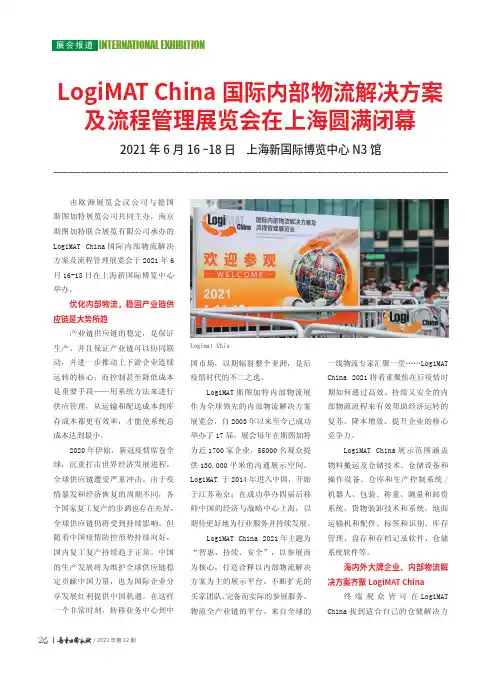


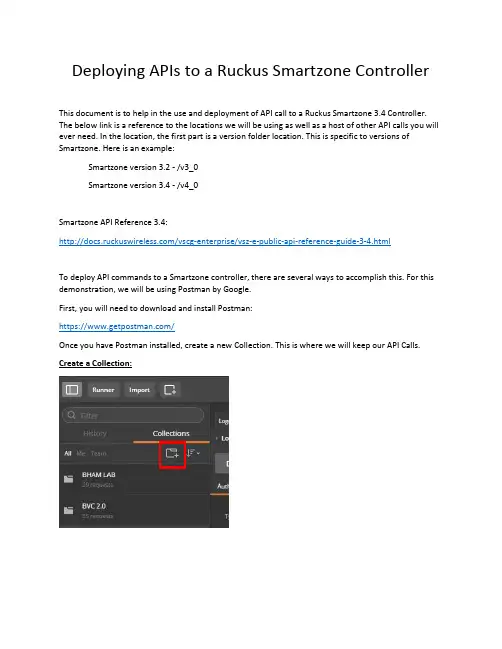
Deploying APIs to a Ruckus Smartzone Controller This document is to help in the use and deployment of API call to a Ruckus Smartzone 3.4 Controller. The below link is a reference to the locations we will be using as well as a host of other API calls you will ever need. In the location, the first part is a version folder location. This is specific to versions of Smartzone. Here is an example:Smartzone version 3.2 - /v3_0Smartzone version 3.4 - /v4_0Smartzone API Reference 3.4:/vscg-enterprise/vsz-e-public-api-reference-guide-3-4.htmlTo deploy API commands to a Smartzone controller, there are several ways to accomplish this. For this demonstration, we will be using Postman by Google.First, you will need to download and install Postman:https:///Once you have Postman installed, create a new Collection. This is where we will keep our API Calls. Create a Collection:Create an Environment:Select the Gear and Manage Environments:Select Add:Give the Environment a Name and Select Add:Inside the Environment is where we will define variables for you API calls. The Key will be the variable name and the Value will be the value for the Key.You will need to add two header values to every API you create. Below is an explanation and the values.Create a Login Session API Call:Select POST and add the destination to the controller and the location for this call. I have used a variable for the destination. Here is a break down:{{LabvSz}} - https://{host}:7443/api/public (Where {host} is the IP Address or Hostname of your controller). If you use the {{LabvSz}}, this is a variable created in your environment./v4_0/session is the location.Under the Headers Tab, add the two fields for all your API Calls:Content-Type - application/json;charset=UTF-8Cookie - JSESSIONID={JSESSIONID}Headers TabUnder the Body Tab, you need to add the username and password to login to the controller. You will use the raw format and it must be formatted exactly as below. The apiVersion can be left to the default and the timeZoneUtcOffset is the time zone of the controller.Body TabWhen you are done, select the down arrow next to Save to do Save As.Save the API to the Collection Name you created earlier.Retrieve the System Summary API:Now we are going to create an API to Retrieve the System Summary.For this call Use GET and add the destination URL plus the location (/v4_0/controller). Remember to add the header information as above and Save AS when you are done.To execute this call, select the send button.Below is a Sample Output:Retrieve AP List API:Now we are going to create an API to retrieve a list of APs from the controller.For this call Use GET and add the destination URL plus the location (/v4_0/aps). Remember to add the header information as above and Save AS when you are done. Below is the command and sample output.AP MACIn this example, we received a list of APs from the controller. I only have one AP. From here we can get the MAC Address of the AP to use in the next API.Retrieve AP Information API:Now we are going to create an API to retrieve information about a specific AP from the controller.For this call Use GET and add the destination URL plus the location (/v4_0/aps/{apMac}). For this example, we need the AP MAC Address from the last example to replace {apMac}. Remember to add the header information as above and Save AS when you are done. Below is the command and sample output.AP MACNow we are going to create an API to retrieve a list of AP Zones from the controller.For this call Use GET and add the destination URL plus the location (/v4_0/rkszones). Remember to add the header information as above and Save AS when you are done. Below is the command and sample output.Default Zone ID We will use the “Default Zone” ID to perform the next API.Now we are going to create an API to create a WLAN Group on the controller.For this call Use POST and add the destination URL plus the location(/v4_0/rkszones/{zoneId}/wlangroups). Remember to add the header information as above. Here wewill also have to add information to the Body Tab. The body tab has the name of the WLAN Group we want to create and the Description. This is input in the raw format. Refer to the API Guide for more details. Be sure to Save AS when you are done. Below is the command and sample output.Zone ID fromprevious exampleBody TabInput must be formattedexactly as aboveWhen you execute this command with the Send Button, you will see the following:ID for new WLAN GroupNow we are going to create an API to delete a WLAN Group on the controller.For this call Use DELETE and add the destination URL plus the location(/v4_0/rkszones/{zoneId}/wlangroups/{id}). We will use the zone ID from the previous example and the ID of the WLAN Group we want to delete. This can be found from a retrieve WLAN List API. Rememberto add the header information as above and Save AS when you are done.Below is the output from the Retrieve WLAN Group List: Total Count is 2 for my example.ID of the WLAN Group todeleteBelow is the command and sample output.Now we run the WLAN Group Retrieve API again and the group has been deleted. Total Count is now one.ID of the WLAN Group todeleteCreate a Logout API:When you are finished, we need to logout of the controller. For this call Use DELETE and add the destination URL plus the location (/v4_0/session). Remember to add the header information as above and Save AS when you are done.This is only the beginning of the APIs you can create. Please refer to the API Guide for reference.。

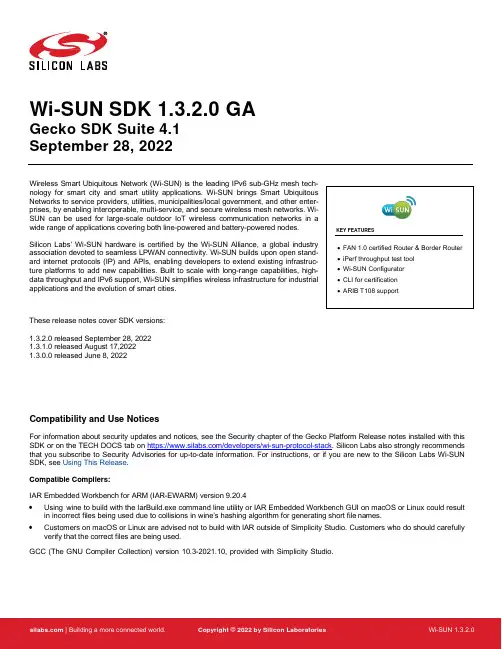
Wi-SUN SDK 1.3.2.0 GAGecko SDK Suite 4.1 September 28, 2022Wireless Smart Ubiquitous Network (Wi-SUN) is the leading IPv6 sub-GHz mesh tech-nology for smart city and smart utility applications. Wi-SUN brings Smart Ubiquitous Networks to service providers, utilities, municipalities/local government, and other enter-prises, by enabling interoperable, multi-service, and secure wireless mesh networks. Wi-SUN can be used for large-scale outdoor IoT wireless communication networks in a wide range of applications covering both line-powered and battery-powered nodes. Silicon Labs' Wi-SUN hardware is certified by the Wi-SUN Alliance, a global industry association devoted to seamless LPWAN connectivity. Wi-SUN builds upon open stand-ard internet protocols (IP) and APIs, enabling developers to extend existing infrastruc-ture platforms to add new capabilities. Built to scale with long-range capabilities, high-data throughput and IPv6 support, Wi-SUN simplifies wireless infrastructure for industrial applications and the evolution of smart cities.These release notes cover SDK versions: 1.3.2.0 released September 28, 2022 1.3.1.0 released August 17,2022 1.3.0.0 released June 8, 2022Compatibility and Use NoticesFor information about security updates and notices, see the Security chapter of the Gecko Platform Release notes installed with this SDK or on the TECH DOCS tab on https:///developers/wi-sun-protocol-stack . Silicon Labs also strongly recommends that you subscribe to Security Advisories for up-to-date information. For instructions, or if you are new to the Silicon Labs Wi-SUN SDK, see Using This Release . Compatible Compilers:IAR Embedded Workbench for ARM (IAR-EWARM) version 9.20.4 •Using wine to build with the IarBuild.exe command line utility or IAR Embedded Workbench GUI on macOS or Linux could result in incorrect files being used due to collisions in wine’s hashing algorithm for generating short file names.•Customers on macOS or Linux are advised not to build with IAR outside of Simplicity Studio. Customers who do should carefully verify that the correct files are being used.GCC (The GNU Compiler Collection) version 10.3-2021.10, provided with Simplicity Studio.Contents Contents1Wi-SUN Stack (2)1.1New Items (2)1.2Improvements (2)1.3Fixed Issues (2)1.4Known Issues in the Current Release (3)1.5Deprecated Items (3)1.6Removed Items (3)2Wi-SUN Applications (4)2.1New Items (4)2.2Improvements (4)2.3Fixed Issues (4)2.4Known Issues in the Current Release (4)2.5Deprecated Items (4)2.6Removed Items (4)3Using This Release (5)3.1Installation and Use (5)3.2Security Information (5)3.3Support (6)1 Wi-SUN Stack1.1 New ItemsAdded in release 1.3.0.0•Most of the stack crypto operations are now made through ARM PSA Crypo API.•Added a new API sl_wisun_set_device_private_key_id() that indicates which PSA Crypto key handler contains the de-vice private key and has to be used by the stack. It is the application’s responsibility to create the key.•Added a new API sl_wisun_set_regulation() that configures the regional regulation to which the stack must comply. Refer to UG495: Silicon Labs Wi-SUN Developer's Guide for more information about regional regulation in the Wi-SUN Stack.•Added a new event SL_WISUN_MSG_REGULATION_TX_LEVEL_IND_ID that is fired when the transmission budget crosses one of the transmission budget thresholds. The transmission budget is defined by the regional regulation. Refer to UG495: Silicon Labs Wi-SUN Developer's Guide for more information about regional regulation in the Wi-SUN Stack.•Added a new API sl_wisun_set_regulation_tx_thresholds()that configures the threshold used to fire SL_WISUN_MSG_REGULATION_TX_LEVEL_IND_ID event.•Added a new API sl_wisun_set_advert_fragment_duration() that configures the asynchronous transmission fragment duration. It can be used to reduce the impact on the latency of long advertisement periods.•Added a new API sl_wisun_set_unicast_tx_mode() that enables a high-reliability transmission mechanism for unicast communication. It trades off unicast communication reliability for latency.1.2 ImprovementsChanged in release 1.3.1.0•When ARIB radio regulation is selected, the stack refuses all EDFE initialization requests sending an EDFE final frame.Changed in release 1.3.0.0•sl_wisun_set_channel_mask() channel filter is now applied to asynchronous transmissions and unicast listening schedule.The function was renamed sl_wisun_set_allowed_channel_mask() to make it more self-explanatory.1.3 Fixed IssuesFixed in release 1.3.2.01023782 Fixed an invalid Path Control field configuration in RPL DAO packet.Fixed in release 1.3.1.0851960 Fixed PAN Advert and PAN Config Trickle timer configuration. Inconsistent transmissions were not correctly managed. It could lead to suboptimal behavior in dense areas of a network.840698Fixed a performance issue that was causing Linux Border Router RCP to become unreachable when running throughput tests with high-speed data rates. That issue was fixed by using DMA to collect UART data.853035 Fixed an initialization issue that was causing PAN Advert and PAN Config asynchronous transmission requests to be dropped. That issue was most likely to happen with TEST and SMALL network size configuration and couldcause connection durations to be significantly longer.Fixed in release 1.3.0.0Fixed an error that was causing radio calibrations to be skipped during Wi-SUN Stack initialization. 8134407742901.4 Known Issues in the Current ReleaseNone1.5 Deprecated ItemsNone1.6 Removed ItemsNoneWi-SUN Applications 2 Wi-SUN Applications2.1 New ItemsAdded in release 1.3.0.0iPerf2 support•Integrated into Wi-SUN - SoC Network Measurement Application•Option to install the Iperf2 component to other applications alsoWi-SUN Configurator – UI Tool•Configuration options are being used by the Applications automatically•MAC Address•MAC Allow/Deny List•Unicast Dwell IntervalCoAP discovery feature (limited, RFC 6690):•Register Resources•Return list of Registered Resources in response to GET .well-known/core request2.2 ImprovementsAdded in release 1.3.1.0Wi-SUN Linux Border Router RCP•Released version 1.1.0•It now collects UART data using a DMA.2.3 Fixed IssuesNone2.4 Known Issues in the Current ReleaseIssues in bold were added since the previous release.Simplicity Studio – Network Analyzer: Wi-SUN Encrypted Packets arenot supported.2.5 Deprecated ItemsNone2.6 Removed ItemsRemoved in release 1.3.0.0•Wi-SUN - SoC Border Router with backhaul.3 Using This ReleaseThis release contains the following•Wi-SUN stack library•Wi-SUN sample applications•Wi-SUN border router pre-compiled demos•DocumentationIf you are a first time user, see QSG181: Silicon Labs Wi-SUN Quick-Start Guide.3.1 Installation and UseThe Wi-SUN SDK is provided as part of the Gecko SDK (GSDK), the suite of Silicon Labs SDKs. To quickly get started with the GSDK, install Simplicity Studio 5, which will set up your development environment and walk you through GSDK installation. Simplicity Studio 5 includes everything needed for IoT product development with Silicon Labs devices, including a resource and project launcher, software configuration tools, full IDE with GNU toolchain, and analysis tools. Installation instructions are provided in the online Simplicity Studio 5 User’s Guide.Alternatively, Gecko SDK may be installed manually by downloading or cloning the latest from GitHub. See https:///SiliconLabs/gecko_sdk for more information.Simplicity Studio installs the GSDK by default in:•(Windows): C:\Users\<NAME>\SimplicityStudio\SDKs\gecko_sdk•(MacOS): /Users/<NAME>/SimplicityStudio/SDKs/gecko_sdkDocumentation specific to the SDK version is installed with the SDK.3.2 Security InformationSecure Vault IntegrationThis version of the stack does not integrate Secure Vault Key Management.Security AdvisoriesTo subscribe to Security Advisories, log in to the Silicon Labs customer portal, then select Account Home. Click HOME to go to the portal home page and then click the Manage Notifications tile. Make sure that ‘Software/Security Advisory Notices & Product Change Notices (PCNs)’ is checked, and that you are subscribed at minimum for your platform and protocol. Click Save to save any changes.3.3 SupportDevelopment Kit customers are eligible for training and technical support. Contact Silicon Laboratories support at /support.Silicon Laboratories Inc.400 West Cesar Chavez Austin, TX 78701USAIoT Portfolio/IoTSW/HW/simplicityQuality /qualitySupport & Community/communityDisclaimerSilicon Labs intends to provide customers with the latest, accurate, and in-depth documentation of all peripherals and modules available for system and software imple-menters using or intending to use the Silicon Labs products. Characterization data, available modules and peripherals, memory sizes and memory addresses refer to each specific device, and “Typical” parameters provided can and do vary in different applications. Application examples described herein are for illustrative purposes only. Silicon Labs reserves the right to make changes without further notice to the product information, specifications, and descriptions herein, and does not give warranties as to the accuracy or completeness of the included information. Without prior notification, Silicon Labs may update product firmware during the manufacturing process for security or reliability reasons. Such changes will not alter the specifications or the performance of the product. Silicon Labs shall have no liability for the consequences of use of the infor -mation supplied in this document. This document does not imply or expressly grant any license to design or fabricate any integrated circuits. The products are not designed or authorized to be used within any FDA Class III devices, applications for which FDA premarket approval is required or Life Support Systems without the specific written consent of Silicon Labs. A “Life Support System” is any product or system intended to support or sustain life and/or health, which, if it fails, can be reasonably expected to result in significant personal injury or death. Silicon Labs products are not designed or authorized for military applications. Silicon Labs products shall under no circumstances be used in weapons of mass destruction including (but not limited to) nuclear, biological or chemical weapons, or missiles capable of delivering such weapons. Silicon Labs disclaims all express and implied warranties and shall not be responsible or liable for any injuries or damages related to use of a Silicon Labs product in such unauthorized applications. Note: This content may contain offensive terminology that is now obsolete. Silicon Labs is replacing these terms with inclusive language wherever possible. For more information, visit /about-us/inclusive-lexicon-projectTrademark InformationSilicon Laboratories Inc.®, Silicon Laboratories ®, Silicon Labs ®, SiLabs ® and the Silicon Labs logo ®, Bluegiga ®, Bluegiga Logo ®, EFM ®, EFM32®, EFR, Ember ®, Energy Micro, Energy Micro logo and combinations thereof, “the world’s most energy friendly microcontrollers”, Redpine Signals ®, WiSeConnect , n-Link, ThreadArch ®, EZLink ®, EZRadio ®, EZRadioPRO ®, Gecko ®, Gecko OS, Gecko OS Studio, Precision32®, Simplicity Studio ®, Telegesis, the Telegesis Logo ®, USBXpress ® , Zentri, the Zentri logo and Zentri DMS, Z-Wave ®, and others are trademarks or registered trademarks of Silicon Labs. ARM, CORTEX, Cortex-M3 and THUMB are trademarks or registered trademarks of ARM Holdings. Keil is a registered trademark of ARM Limited. Wi-Fi is a registered trademark of the Wi-Fi Alliance. All other products or brand names mentioned herein are trademarks of their respective holders.。

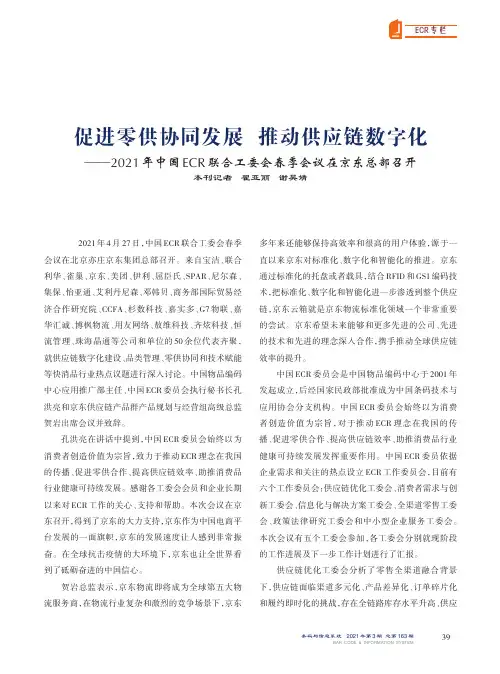
条码与信息系统2021年第3期总第163期BAR CODE &INFORMATION SYSTEM促进零供协同发展推动供应链数字化——2021年中国ECR 联合工委会春季会议在京东总部召开本刊记者翟亚丽谢昊婧ECR 专栏2021年4月27日,中国ECR 联合工委会春季会议在北京亦庄京东集团总部召开。
来自宝洁、联合利华、雀巢、京东、美团、伊利、屈臣氏、SPAR 、尼尔森、集保、怡亚通、艾利丹尼森、邓韩贝、商务部国际贸易经济合作研究院、CCFA 、杉数科技、嘉实多、G7物联、嘉华汇诚、博枫物流、用友网络、敖维科技、齐炫科技、恒流管理、珠海晶通等公司和单位的50余位代表齐聚,就供应链数字化建设、品类管理、零供协同和技术赋能等快消品行业热点议题进行深入讨论。
中国物品编码中心应用推广部主任、中国ECR 委员会执行秘书长孔洪亮和京东供应链产品群产品规划与经营组高级总监贺岩出席会议并致辞。
孔洪亮在讲话中提到,中国ECR 委员会始终以为消费者创造价值为宗旨,致力于推动ECR 理念在我国的传播、促进零供合作、提高供应链效率、助推消费品行业健康可持续发展。
感谢各工委会会员和企业长期以来对ECR 工作的关心、支持和帮助。
本次会议在京东召开,得到了京东的大力支持,京东作为中国电商平台发展的一面旗帜,京东的发展速度让人感到非常振奋。
在全球抗击疫情的大环境下,京东也让全世界看到了砥砺奋进的中国信心。
贺岩总监表示,京东物流即将成为全球第五大物流服务商,在物流行业复杂和激烈的竞争场景下,京东多年来还能够保持高效率和很高的用户体验,源于一直以来京东对标准化、数字化和智能化的推进。
京东通过标准化的托盘或者载具,结合RFID 和GS1编码技术,把标准化、数字化和智能化进一步渗透到整个供应链,京东云箱就是京东物流标准化领域一个非常重要的尝试。
京东希望未来能够和更多先进的公司、先进的技术和先进的理念深入合作,携手推动全球供应链效率的提升。
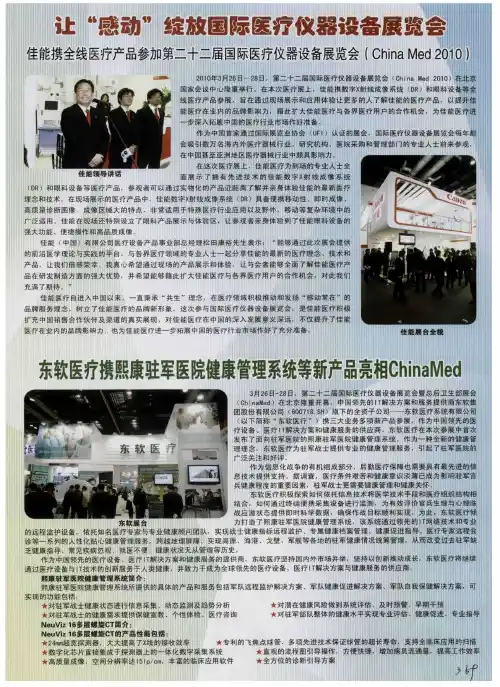
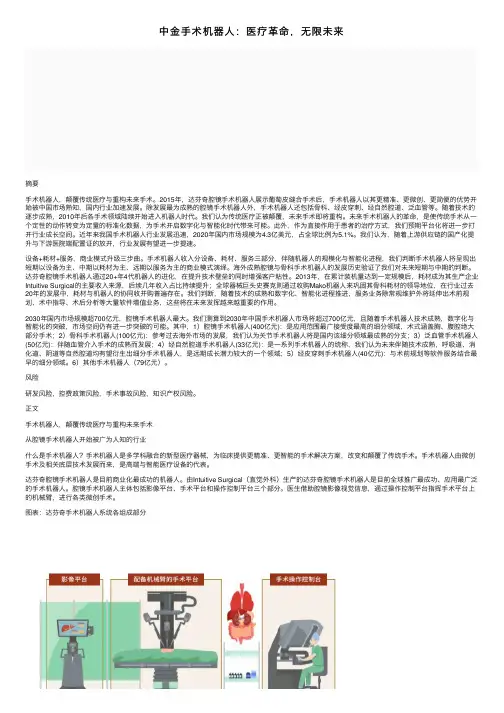
中⾦⼿术机器⼈:医疗⾰命,⽆限未来摘要⼿术机器⼈,颠覆传统医疗与重构未来⼿术。
2015年,达芬奇腔镜⼿术机器⼈展⽰葡萄⽪缝合⼿术后,⼿术机器⼈以其更精准、更微创、更简便的优势开始被中国市场熟知,国内⾏业加速发展。
除发展最为成熟的腔镜⼿术机器⼈外,⼿术机器⼈还包括⾻科、经⽪穿刺、经⾃然腔道、泛⾎管等。
随着技术的逐步成熟,2010年后各⼿术领域陆续开始进⼊机器⼈时代。
我们认为传统医疗正被颠覆,未来⼿术即将重构。
未来⼿术机器⼈的⾰命,是使传统⼿术从⼀个定性的动作转变为定量的标准化数据,为⼿术开启数字化与智能化时代带来可能。
此外,作为直接作⽤于患者的治疗⽅式,我们预期平台化将进⼀步打开⾏业成长空间。
近年来我国⼿术机器⼈⾏业发展迅速,2020年国内市场规模为4.3亿美元,占全球⽐例为5.1%。
我们认为,随着上游供应链的国产化提升与下游医院端配置证的放开,⾏业发展有望进⼀步提速。
设备+耗材+服务,商业模式升级三步曲。
⼿术机器⼈收⼊分设备、耗材、服务三部分,伴随机器⼈的规模化与智能化进程,我们判断⼿术机器⼈将呈现出短期以设备为主、中期以耗材为主、远期以服务为主的商业模式演绎。
海外成熟腔镜与⾻科⼿术机器⼈的发展历史验证了我们对未来短期与中期的判断。
达芬奇腔镜⼿术机器⼈通过20+年4代机器⼈的进化,在提升技术壁垒的同时增强客户粘性。
2013年,在累计装机量达到⼀定规模后,耗材成为其⽣产企业Intuitive Surgical的主要收⼊来源,后续⼏年收⼊占⽐持续提升;全球器械巨头史赛克则通过收购Mako机器⼈来巩固其⾻科耗材的领导地位,在⾏业过去20年的发展中,耗材与机器⼈的协同收并购普遍存在。
我们判断,随着技术的成熟和数字化、智能化进程推进,服务业务除常规维护外将延伸出术前规划、术中指导、术后分析等⼤量软件增值业务,这些将在未来发挥越来越重要的作⽤。
2030年国内市场规模超700亿元,腔镜⼿术机器⼈最⼤。
我们测算到2030年中国⼿术机器⼈市场将超过700亿元,且随着⼿术机器⼈技术成熟,数字化与智能化的突破,市场空间仍有进⼀步突破的可能。
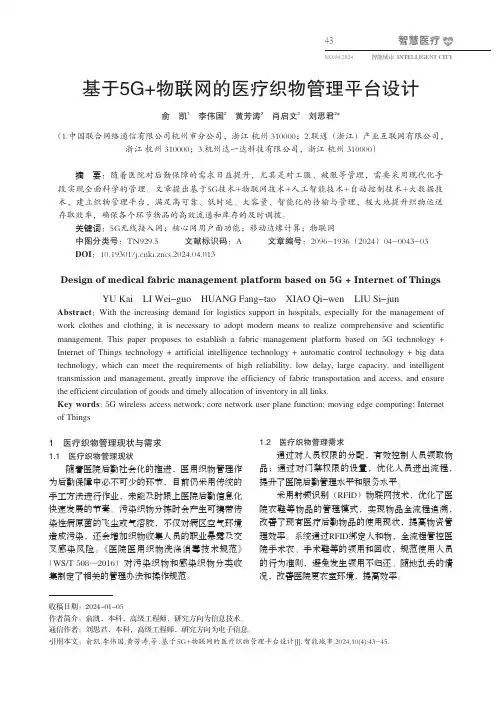
智慧医疗NO.04 202443智能城市 INTELLIGENT CITY基于5G+物联网的医疗织物管理平台设计俞凯1李伟国2黄芳涛3肖启文2刘思君2*(1.中国联合网络通信有限公司杭州市分公司,浙江 杭州 310000;2.联通(浙江)产业互联网有限公司,浙江 杭州 310000;3.杭州达一达科技有限公司,浙江 杭州 310000)摘要:随着医院对后勤保障的需求日益提升,尤其是对工服、被服等管理,需要采用现代化手段实现全面科学的管理。
文章提出基于5G技术+物联网技术+人工智能技术+自动控制技术+大数据技术,建立织物管理平台,满足高可靠、低时延、大容量、智能化的传输与管理,极大地提升织物运送存取效率,确保各个环节物品的高效流通和库存的及时调拨。
关键词:5G无线接入网;核心网用户面功能;移动边缘计算;物联网中图分类号:TN929.5 文献标识码:A 文章编号:2096-1936(2024)04-0043-03DOI:10.19301/ki.zncs.2024.04.013Design of medical fabric management platform based on 5G + Internet of Things YU Kai LI Wei-guo HUANG Fang-tao XIAO Qi-wen LIU Si-jun Abstract:With the increasing demand for logistics support in hospitals, especially for the management of work clothes and clothing, it is necessary to adopt modern means to realize comprehensive and scientific management. This paper proposes to establish a fabric management platform based on 5G technology + Internet of Things technology + artificial intelligence technology + automatic control technology + big data technology, which can meet the requirements of high reliability, low delay, large capacity, and intelligent transmission and management, greatly improve the efficiency of fabric transportation and access, and ensure the efficient circulation of goods and timely allocation of inventory in all links.Key words:5G wireless access network; core network user plane function; moving edge computing; Internet of Things1 医疗织物管理现状与需求1.1 医疗织物管理现状随着医院后勤社会化的推进,医用织物管理作为后勤保障中必不可少的环节,目前仍采用传统的手工方法进行作业,未能及时跟上医院后勤信息化快速发展的节奏。
RUCKUS美国优科无线产品介绍大全《产品目录》无线控制器- ZoneDirector 3000系列 (3)无线控制器 - ZoneDirector 1000系列 (10)无线接收器 - 室内11n ZoneFlex 7942 (15)无线接收器 - 室外11n ZoneFlex 7942-OT (21)无线接收器 - 室内11g ZoneFlex 2942 (27)无线接收器 - 室外11g ZoneFlex 2942-OT (35)无线接收器 - 室外大功率(500mw)ZoneFlex 2741 (40)无线接收器- 室内双频11n ZoneFlex 7962 (48)无线接收器- 室外双频11n ZoneFlex 7762 (54)无线接收器- 室内大功率(500mw)ZoneFlex 2942-FB (60)无线接收器- 室外大功率(500mw)ZoneFlex 2942-FBOT (65)无线网络管理系统– FlexMaster (72)无线控制器- ZoneDirector 3000系列Ruckus ZoneDirector 3000是首个企业级智能无线局域网系统,它在一个很低的总体拥有成本上,提供了一个安全、可靠,同时又易于扩展的无线局域网解决方案。
Ruckus ZoneDirector 3000的设计理念力求简洁而易用,通过一个中央点,其最多可以管理500台ZoneFlex 802.11b/g和802.11n,以及室内室外的智能无线AP。
完全不像传统的无线局域网那么昂贵、复杂、难以部署,对任何一个需要高性能无线局域网而又期望其易于实施和管理的企业来说,选用ZoneDirector 3000都是再合适不过的了。
ZoneDirector 3000集成了很多高级的功能,诸如智能天线操纵,智能无线网状结构,以及动态无线安全等,这些都是你在其他的WLAN系统中见不到的。
Ruckus ZoneDirector 3000可以由非无线网络专业人员进行部署和操作,安装非常快速简便。
数据表Ruckus智能接入管理服务将智能 WI-FI 移入云端智能接入管理 (SAM) 是第一个运营商级,托管公共云 Wi-Fi 服务。
SAM 融合了一流 Wi-Fi 与云计算,从而简化公共 Wi-Fi 接入的配置、管理和盈利。
SAM 结合所有必需的组件,以便提供 WLAN 管理、社交登录、身份认证、内容控制和广告选项等公共 Wi-Fi 接入并将其迁移到云端。
在降低成本的同时,可简化并加快公共 Wi-Fi 接入的部署而不会降低性能或功能。
通过 SAM 实现更加优异的公共 Wi-FiSAM 公共 Wi-Fi 接入模式包括经过培训的授权 Ruckus 渠道合作伙伴提供的安装、灵活的部署选项和实现轻松盈利所需的工具、以及丰富的分析和人数统计数据。
SAM 最适合需要单个 Wi-Fi 接入点且可扩展至支持成百上千接入点的大型多站点部署的小型场地。
功能特色和优势• 运营商级云 Wi-Fi 支持按需付费服务模式• 针对小型到大型部署的经济高效解决方案支持成千上万的客户端设备• 凭借简化安装、部署和配置过程缩短投放市场的时间。
• 灵活的 Wi-Fi 部署选项支持云托管或现场管理• 设计易于安装和使用,采用直观基于云的门户• 配备的强大盈利工具可为广告和品牌营销提供平台• 模块化配置屏幕无需技术高超的 IT人员进行安装和不间断管理将智能 WI-FI 移入云端安装便捷借助 Ruckus 智能接入管理部署公共 Wi-Fi 从未如此轻松。
利用 SAM 云托管订阅模式的灵活性以及安装便捷的特点,可在数分钟内部署该解决方案。
极大地减少了部署公共Wi-Fi 接入耗费的时间。
安装包括需要 Ruckus 增值分销商 (VAR) 参与安装过程的3 个步骤。
1) 订阅和定义:为带有服务参数的热点、用户体验、广告和登录选项定义服务2) 配置和部署:由客户场所的 Ruckus 合作伙伴配置并部署 Wi-Fi3) 管理和盈利:凭借配置的 Wi-Fi 和热点服务,客户从可行的粒度分析中获利,并借助品牌营销和广告商机通过 Wi-Fi盈利灵活的部署选项Ruckus 可为新客户或现有客户提供灵活的部署选项,部署现成的 Ruckus WLAN 基础设施。
Ruckus ZoneDirector 1000Ruckus ZoneDirector 1000是业界第一个专为中小企业和热点运营商多媒体无线局域网(WLAN)解决方案而设计的集中管理系统。
结合Ruckus ZoneFlex 智能多媒体无线AP,ZoneDirector 1000在相当低的整体拥有成本基础上提供了完整、安全可靠和易于扩展的无线局域网 (WLAN)解决方案。
以简约和方便使用为设计思路的Ruckus ZoneDirector 1000可以在没有无线专业人员的情况下简单快速地部署和维护。
任何只有有限IT资源和预算的企业都可以在几分钟内建立一个企业级、安全的无线局域网(WLAN)解决方案。
Ruckus ZoneDirector 1000是专为填补单个功能缺乏的消费AP和昂贵、复杂的高端企业系统之间的空白,为中小企业应用环境而设计的。
Ruckus ZoneDirector对需要一个安全可靠、容易部署、集中管理和自适应无线局域网(WLAN)的中小企业是理想的解决方案。
ZoneDirector 1000对想为酒店、机场、学校和公共建筑等地点提供商用级热点业务如VoWLAN、IP视频、企业安全接入延伸和不同等级服务的热点运营商也是完美的解决方案。
Ruckus ZoneDirector可非常容易通过WEB向导简单点击配置完成与现有网络、安全和认证系统集成,Ruckus ZoneFlexAP会自动发现ZoneDirector并由ZoneDirector进行配置。
冗余和安全,Ruckus ZoneDirector可在一个容易使用和负担得起的无线局域网(WLAN)系统中提供遍及整个WLAN范围的网络、安全、无线信道和位置管理。
优势便于使用和管理集中管理,快速设置,即时配置和自动、实时地对整个无线局域网(WLAN)优化无需专业人员支持,5分钟内完成部署基于WEB的配置向导能使任何计算机用户在几分钟内配置整个无线局域网(WLAN)。
RUCKUS携手JOYMAKE 打造物联网医疗解决方案1、随着医院信息化的发速发展,基于无线网络的临床医疗以其快捷方便和未来的发展趋势得到越来越多的关注。
医疗信息化已经到了移动医疗时代,在这个时代,医生不再是拿着厚重的资料本到病房去查房了,而是携带移动临床终端,移动临床终端结合了医院流程,将极大得提升医生工作效率,同时可以为病人提供更好的服务和治疗。
新的医院规划部署更为先进无线网络,以满足未来无线临床、无线诊疗、无线传感与定位、无线追踪等多方位的医院无线应用。
2、美国RUCKUS不仅提供室内、室外、点对点的全面无线解决方案更以智能天线技术真正成为无死角的无线网络覆盖。
为了进一步解决医疗机构信息化应用,美国RUCKUS携手其战略合作伙伴上海聚美物联网(JOYMAKE)共同推出基于WIFI的传感与定位技术。
3、随着无线医疗的发展,基于无线WiFi的应用得到迅速发展,医疗机构可以凭借一套网络管理资产、人员、信息采集,让管理更方便,成本更低廉。
4、JOYMAKE基于无线的应用:
JOYMAKE HMRST 医疗信息系统可以与HIS、EMR、RIS/PACS、LIS、OA等等系统无缝集成形成医院完整的医疗信息系统,支持所有移动设备。
4.1 无线门诊输液系统
门诊输液系统由条形码、智能识别、无线网络组成。
充分发挥现有HIS系统作用,实现病人信息自动管理。
护士采用手持PDA标签确认病人身份,扫描输液软带上标签确认药品,减少了工作隐患。
病人-门诊输液室护士台-扫描处方条形码-打印双联条形码-医师配药-扫描病人身份条码标签-输液
4.2无线移动查房系统
医护人员可以通过在医院的手推车上安装的计算机、或者移动无线临床医疗终端、护士PDA 等设备,无线接入EMR(Electronic Medical Record)。
比如,临床医生可以推着一辆手推车探视患者,并从患者的床边,迅速地获取患者的住院信息、病史、化验结果和其他患者数据。
此外,临床医生还可以在转移到下一张病床之前,
通过该应用更新患者的病历、预约化验和开处方。
所有信息都将通过无线网络,记录在医院的主数
据库中。
护士可以在病人床前实时将病人的体温、
血压、血糖、服药等情况通过无线网络及时的更
新进入系统,以便医生及医技科室调用及查询,
直接获取。
4.3无线快速交费取药
看完医生后的处方单等也都由电脑打印出来并带有条码信息。
这样在病人交费的时候.只要在排号机前扫瞄一下储存一个号.就可以等待被呼叫交费了.此时医生所开的药物或检查项目、费用明细也都已经显示在电脑屏幕上,自然就不用排队了。
在药房,以前是先交处方,再备药,等待时间很长。
现在是收费完成之后配药单自动传到药房后台.准备药之后再扫瞄一下,就医者就可以直接到窗口领药。
药师扫描条形码核对处方,系统自动核检库存。
这对于就医者来说是不用排队了,而对于药剂师来说,通过整个过程的
计算机管理。
药师不需要敲一下键盘,不需要按一下鼠标,避免了发药时候可能出现的错误。
4.5无线定位
使用适当的无线基础设施实施实时定位服务,其边际成本是微不足道的,而收益却是巨大的。
定位服务适用于医院,因为它的实施几乎不需要成本,却可以帮助医院节省大量的管理费用,以及削减部分高价值物品的库存量,同时大大降低耐用设备损耗。
我们常常可以去定位手术包、移动手推车、追踪医疗垃圾车去向等重要移
动资产。
此外,通过追踪可能危及他人的传染病患者,能
够有效降低医院的交叉感染率,并且在关键时刻提高医生
的反应速度。
4.6无线导医
日常生活中,我们不少人都有过在医院排长队挂号买
药的经验,也不乏因为医生笔迹不清楚而在收费处,化验
科室与医生问诊室之间跑来跑去、问来问去的经历。
随着人们生活质量的进一步提高,对健康生活的渴望也愈加强烈,这些都无可避免地要求医疗的信息化程度相应提升我们结合无线网络及定位技术,在医院设置导医功能。
患者手持导医终端在需要的位置被触发后,可以播放该科室的介绍和告之患者所在位置以及下一步要去的位置导向。
当然我们还可以发布一些娱乐信息给导医终端,真正让患者在就医的时候轻松起来。
4.7无线自动库存管理
结合定位功能我们常常可以在药品进出库的地方放置触发器,当成箱的药品进入仓库后我们不需要一一扫描,系统自动读完数据并记录保存。
当药品要被出库时同样会被系统记录。
自动减去库存。
降低人工录入敲错键盘的风险。
4.8无线婴儿防盗
当医院统一架构了WIFI网络后传统的
RFID婴儿防盗就不需要了。
由于WIFI网络具
有穿透力强、距离覆盖远等优点用来做婴儿
防盗是恰到好处。
我们在婴儿脚踝处装有防
菌医用级的腕带(破坏自动报警),在幼婴看
护层的大门装有JOYMAKE触发器,一旦婴儿
被离开楼层就会被触发报警,而且只要在
WIFI覆盖范围内都将指导婴儿的位置和历史
行动轨迹。
医院可以用一套网络解决婴儿防
盗的问题。
4.9无线标本检验
每个病房的护士根据医生在医嘱系统中留下的病人检验要求,在护士站中打印标签,并粘贴在相应的化验单和样本容器上。
这张标签的内容包括:病人唯一的身份标识条码;病人姓名、年龄、床位等基本信息;病人检验的项目等内容。
使得在样本传递、检验、结果反馈的每一个环节都能够通过条码及相关信息准确地确认病人身份。
整个过程,从护士到化验员的每一个人都能够利用手持数据终端进行扫描和打印条码,减少标本采集和分析过程中的出错率。
他们能够在正确的时间把正确的标本和数量放到正确的容器中。
此外,化验分析结果也得到迅速记载,供医生做出正确决策,实现及时治疗。
实现病人从看病开始,门诊、收
费、检验、取药等有关信息都跟随病人自动在
HIS系统上流转,再也不用拿着一张病单来回跑。
5、呼叫系统
5.1传统有线呼叫系统施工繁琐、检修困难、施工成本高,更重要的是有线系统没有移动接收呼叫信息的功能,使很多病人丧失了抢救的良机。
随着医院、养老院的医疗条件的不断提高,越来越多的场所采用无线呼叫系统,施工和维护简便,呼叫操作简单,医护人员可随时随地接收病人的呼叫。
在我们实际调研中发现病人往往在医生没有来之前会重复呼叫,焦虑等待.JOYMAKE为病人的呼叫系统提供了双向功能。
服务质量往往是由于沟通不畅造成的。
5.2系统功能
当医疗机构已经部署好Wi-Fi网络后,joymake 呼叫系统基于WIFI网络部署,让您的WIFI网络价值得到充分提升,大大提高管理便捷。
病人通过呼叫标签上的红色按钮呼叫。
指示灯会变为红色闪烁,表示呼叫请求已经发出,这时候无线网络会将信号传送到护士站、或者正在查房的医生。
系统会在医务人员的系统平台上弹出提示框,并伴有提示音。
接受终端可以是工作站电脑或者是移动查访终端。
义务人员给出确认后,呼叫按钮标指示灯会由红色变为绿色,患者可以安心等待。
当护士到病房边时可以按下红色按钮表示该呼叫过程结束,请求得到服务。
5.3系统架构
JOYMAKE呼叫系统由呼叫标签、无线AP、无线呼叫服务器、PDA组成。
6、医院信息采集
日新月异发展中的无线传感以及相关物联网技术,为健康信息采集奠定了基础。
使实现“无边界”医疗卫生服务成为可能。
随着生物传感器的不断发展,无线生理传感器网络(WBSN)已逐渐向集成化、微型化、低功耗和智能化等方向发展。
该技术的智能化发展可以实时地、移动地监测患者及特需人群的健康状态,也可实现无线传输、动态显示、智能分析评估治疗效果,进而对潜在的健康危险预先报警。
技术的无线化、低成本的优势,可大大缩减院内常规医疗检查的工作时间,降低院内外监护系统建设和医疗卫生服务的费用。
(注:文件素材和资料部分来自网络,供参考。
请预览后才下载,期待你的好评与关注。
)。